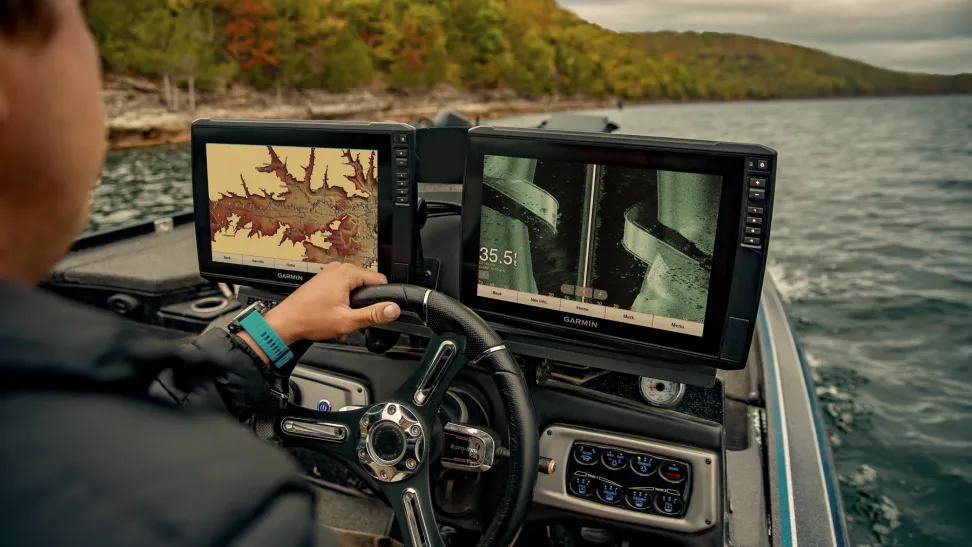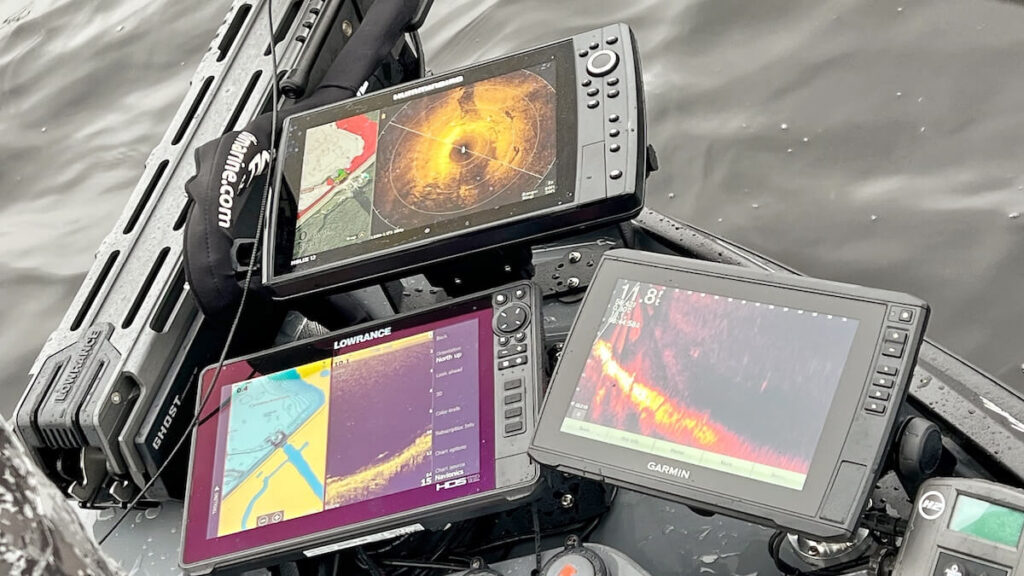Down Imaging on a fish finder is a sophisticated technology that provides anglers with an almost photographic view of what’s directly beneath their boat. Unlike traditional 2D sonar, which emits sound waves in a conical pattern, down imaging sonar sends out thin, high-frequency beams to produce detailed images of structure, revealing fish habitats and underwater landscapes with enhanced clarity. This advanced sonar technology interprets sonar returns meticulously, offering a clearer picture of the water column and the bottom terrain. Anglers accustomed to the broad coverage of traditional 2D sonar will find down imaging to be a game-changer in how they perceive the underwater environment.
Understanding Down Imaging Technology
Down Imaging technology enhances fish finders by offering anglers a clear and detailed view of the underwater world, surpassing the capabilities of traditional 2D sonar.
The Science Behind Down Imaging
The science of down imaging lies in its use of high-frequency sound waves, which are emitted in thin slices rather than the wide cone of traditional sonar. These sound waves bounce off objects and the bottom, with the sonar returns being processed to create a detailed, almost pictorial, representation of the underwater environment. Imaging sonar provides a much finer level of detail compared to traditional 2D sonar, allowing anglers to discern subtle underwater features and fish with greater accuracy.
By utilizing cutting-edge transducer technology, down imaging captures sonar returns from multiple angles. These returns are then compiled into a single image that vividly illustrates the seafloor, including rocks, vegetation, and other structures. The imaging sonar’s advanced signal processing distinguishes fish from other objects, enabling fishers to target their desired species with confidence.
How Down Imaging Transforms Angling
Down imaging has transformed angling by providing a more detailed view of the underwater world than traditional sonar. Anglers can now see with greater precision exactly what is below them, making it easier to identify and target fish habitats. The high-resolution images delivered by down imaging sonar allow for accurate identification of fish and structures, which is particularly beneficial when fishing in unfamiliar waters. By offering a visual representation that is closer to reality, imaging sonar helps anglers make informed decisions on where to cast and how to adjust their techniques, ultimately leading to a more successful and enjoyable fishing experience.

Choosing the Right Imaging for Your Fishing Style
Choosing the right imaging for your fishing style is crucial, as traditional sonar may be sufficient for wide searching, but finer detail required for certain species or techniques is best provided by down imaging.
Kayak Fishing: Is Down Imaging Suitable?
For kayak fishing, where space and weight are considerations, down imaging can be particularly suitable. Its ability to deliver precise images of structure with a compact setup aligns well with the fishing style often adopted by kayak anglers. These fishers typically navigate smaller water bodies or tight spots where detailed information about the immediate underwater environment is invaluable for locating fish.
Down Imaging systems are often compatible with the portability demands of kayak fishing. They can be easily mounted on a kayak and provide clear visual feedback that aids in the stealthy approach kayak anglers prefer. With the right setup, down imaging can enhance the kayak fishing experience significantly, offering high-quality images while maintaining the simplicity and mobility that kayak anglers value.
Trolling Techniques and Imaging Preferences
Trolling techniques benefit greatly from down imaging as they allow anglers to monitor the water directly beneath their moving vessel with exceptional detail. This imaging preference can be a game-changer when searching for suspended fish or navigating around complex underwater structures. The clarity of the images helps in making quick decisions about lure depth and speed adjustments, optimizing the trolling process.
When trolling, the ability to discern fish from cover is paramount, and down imaging provides that edge. Anglers can refine their technique based on the real-time feedback from their fish finder, ensuring they’re presenting their bait in the most effective way. Whether targeting specific depths or following contour lines, down imaging delivers the necessary information for successful trolling.
Recognizing Fish-Holding Structures with Down Imaging
Down Imaging is invaluable for recognizing fish-holding structures that might be overlooked by traditional sonar. The technology’s precision allows anglers to identify potential hotspots, such as submerged trees, rock piles, or weed beds, which are prime locations for fish to congregate. With this tool, anglers can pinpoint these structures, understand their layout, and position their baits more effectively.
By providing anglers with detailed images, down imaging helps in making strategic decisions about where to cast and how to approach different types of structures. This level of insight is especially beneficial for those targeting species that prefer specific habitats or for fishing in waters with complex topographies. The technology ensures that no potential fishing spot goes unnoticed.
Enhancing Your Experience with the Right Transducer
The right transducer is essential to fully harness the capabilities of down imaging, ensuring clear and detailed underwater images.
Selecting a Down Imaging Transducer for Clarity and Depth
When selecting a transducer for down imaging, clarity, and depth are paramount. Anglers should look for models that offer high-frequency capabilities, which are critical for producing the detailed images that down imaging is known for. These transducers often come in compact designs, making them suitable for a variety of fishing vessels, from kayaks to larger boats. It’s essential to match the transducer to the fish finder and the type of fishing it will be used for. Transducers designed for down imaging not only provide the clarity needed for identifying fish and structure but also have the depth range to explore deeper waters.
Installation Considerations for Optimal Imaging Performance
Proper installation of the transducer is crucial for optimal imaging performance. It should be mounted in a location that minimizes turbulence and air bubbles, which can interfere with sonar signals. Anglers must also ensure that the transducer is aligned correctly to provide the best possible view of the underwater terrain. Attention to detail during installation can greatly affect the quality of the down imaging sonar returns.

Q&A Section for Anglers
1. What Is the Main Advantage of Using Down Imaging Over Traditional Sonar?
The main advantage of using Down Imaging over traditional sonar is its ability to provide much clearer and detailed images of the underwater environment. This technology helps anglers to differentiate between fish and other structures with greater precision, making it easier to locate and target fish.
2. Can Down Imaging Work at Great Depths?
Yes, Down Imaging can work at great depths. High-quality transducers designed for down imaging are capable of providing detailed images even in deeper water, allowing anglers to explore and fish in a variety of aquatic environments efficiently.
3. Is Down Imaging Suitable for All Types of Fishing Boats?
Down Imaging is suitable for a wide range of fishing boats, from small kayaks to larger vessels. The key is selecting the appropriate transducer and ensuring it is installed correctly to accommodate the specific boat and fishing conditions.
4. How Does Down Imaging Help With Trolling?
Down Imaging helps with trolling by allowing anglers to see a clear picture of the water column and bottom structure beneath their moving boat. This information is invaluable for adjusting lure depth, and speed, and navigating around underwater features to optimize the chances of catching fish.
Tips and Tricks for Maximizing Down Imaging Efficiency
To fully harness the power of down imaging on your fish finder, it’s essential to start with the correct settings. Adjusting the sensitivity can help distinguish between fish and other underwater objects, as the right level will reduce clutter and enhance target separation. A sensitivity that’s too high may clutter the screen with noise, while a sensitivity that’s too low might miss fish altogether. Experiment with the sensitivity levels until you find a balance that offers a clear and detailed view of the underwater world.
Another vital aspect to consider is the speed of your boat. Down imaging works best at slower speeds, providing a more accurate depiction of the structures and fish below. High speeds can cause the sonar signal to blur, resulting in a less detailed image. For the clearest picture, maintain a steady, slow pace, especially when you’re closely scanning an area for fish activity or bottom contours.
Traditional sonar and down imaging can complement each other. While traditional sonar provides a good overview and depth information, down imaging offers detailed images. Use traditional sonar to locate fish and then switch to down imaging for a more precise view. This combination allows anglers to interpret underwater data effectively and make informed decisions on where to cast their line.
Lastly, keep your fish finder’s software updated. Manufacturers often release updates that improve device performance, including down imaging functionality. These updates can enhance the resolution of images, improve target separation, and even correct any bugs that may affect the performance of your device. Regularly check for updates to ensure that your fish finder is operating at its best.
Final Insights on Down Imaging in Fish Finders
Down imaging has revolutionized the fishing experience by providing anglers with picture-like images of the underwater environment. The high-frequency beam used in down imaging offers excellent target separation and detailed sonar signals. When compared to traditional sonar, down imaging gives a more refined view of the underwater world, enabling anglers to identify fish-holding structures with remarkable clarity.
